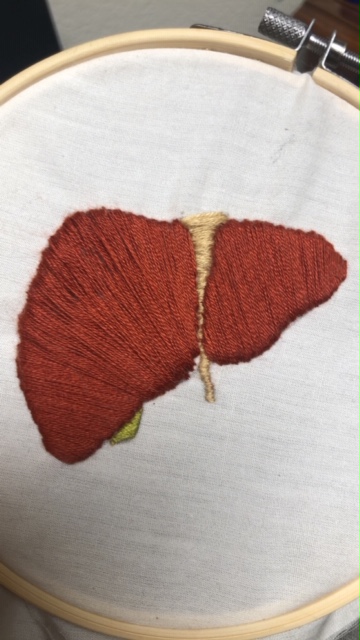I did my STEAM assignment on Hepatocellular Carcinoma, or liver cancer. For my visual aide I made an embroidered healthy liver.

DaeLee Forshaw
Biol112
A Brief Overview of Hepatocellular Carcinoma
Hepatocellular Carcinoma (HCC) is the most common primary liver tumor. Most HCC cells arise from major cells of the liver, the majority of which are hepatocytes. Other cells that can become HCC are biliary epithelial cells, endothelial cells, or combinations of these cells. HCC commonly develops in individuals who have chronic liver disease, with or without cirrhosis. Patients who have cirrhosis are the single most at risk individuals for developing HCC. Other factors for developing HCC are chronic hepatitis B or C, exposure to aflatoxin in developing countries, alcohol abuse and smoking, non alcoholic fatty liver disease (NAFLD), and some hereditary factors such as alpha-1antitrypsin deficiencies. Approximately 30 percent of HCC in non-cirrhotic liver arises from hepatic adenomas. Hepatitis C is the most common cause for HCC in the United States but over the past two decades the rates of NAFLD related HCC have been increasing.
The cells of HCC resemble hepatocytes in function, cytologic features and growth. This can present a diagnostic challenge, when the tumor is less differentiated neoplastic cells lose their hepatocyte traits and features and can even acquire changes seen in other tumors. The tumor cells may excrete bile, this is an exclusive trait to HCC cells. The cells of NAFLD related HCC tumors contain a great deal of fat, inflammation and fibrosis which is consistent with changes seen in fatty liver disease.
HCC form large, solitary circumscribed nodules with or without satellite nodules. In the presence of cirrhosis, it can become multinodular within a single lobe and can consist of multiple nodules scattered through the liver, or it can infiltrate the liver diffusely without forming circumscribed nodules. HCCs are usually soft, tan or yellow and show areas of necrosis and hemorrhage. Large vessel vascular invasion frequency increases with tumor size. The portal vein, hepatic veins and the vena cava can all be involved. Small tumors have the greatest success rate with treatment.
Diagnosis of HCC often consists of imaging, biopsies, and bloodwork. Diagnosis can be difficult due to absence of early symptoms and often leads to diagnosis coming late. As a result, some patients will be terminal at diagnosis. Some symptoms involved in early diagnosis for HCC in patients with cirrhosis are decompensation, ascites, jaundice, and abdominal pain. All of these are already symptoms of cirrhosis which can lead to a delay in diagnosis of HCC, however if the patient is monitored closely with labs HCC can be detected with change or increase in symptoms. Symptoms of patients who do not already have cirrhosis can include abdominal pain, early satiety, palpable mass on abdomen, weight loss, hypoglycemia or hyperglycemia, diarrhea, and some exceedingly rare skin changes.
There are some preventative steps that can be taken to lessen the risk for HCC. Vaccination for hepatitis B virus, treatment for viral hepatitis, medications such as statins, metformin, and aspirin. Some lifestyle modifications can also be helpful in reducing the risk of HCC. This cold be increasing black coffee intake, reducing of body mass, abstinence from alcohol or smoking, and dietary changes.
Bibliography
Kalman, R. S., Abou-Alfa, G. K., & Tanabe, K. K. (2019, September 5). (R. M. Goldberg & A. S. Pappo, Eds.).
Schwartz, J. M., & Carithers, R. L. (2020, March 3). (K. M. Robson, K. K. Tanabe, & A. M. Di Bisceglie, Eds.).
Stuart, K. E. (2020, April 9). (R. M. Goldberg & D. M. F. Savarese, Eds.).
Suriawinata, A., Goldberg, R. M., & Tanabe, K. K. (2019, December 17).

I really like the embroidery of the healthy liver! A lot of people I know have started learning embroidery as a way to pass the time, way to use a hobby for a class setting!
Your essay is very informative about Hepatocellular Carcinoma (HCC), I like the you included the preventative steps at the end as well as information regarding how someone might be increasing their risk of contracting HCC. Great Job!